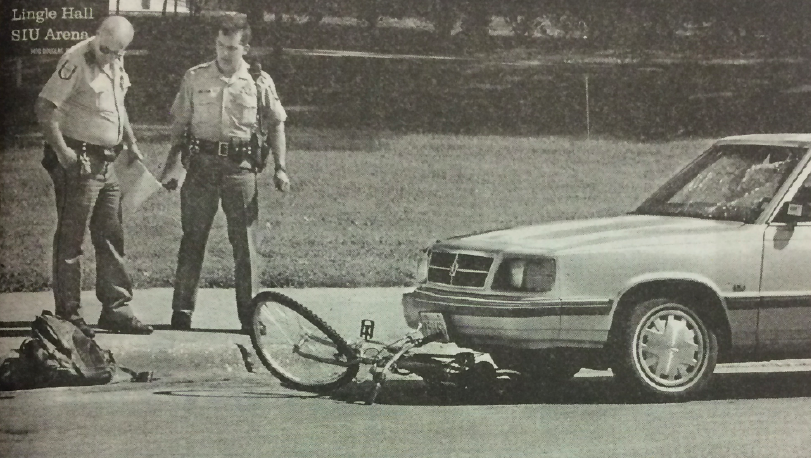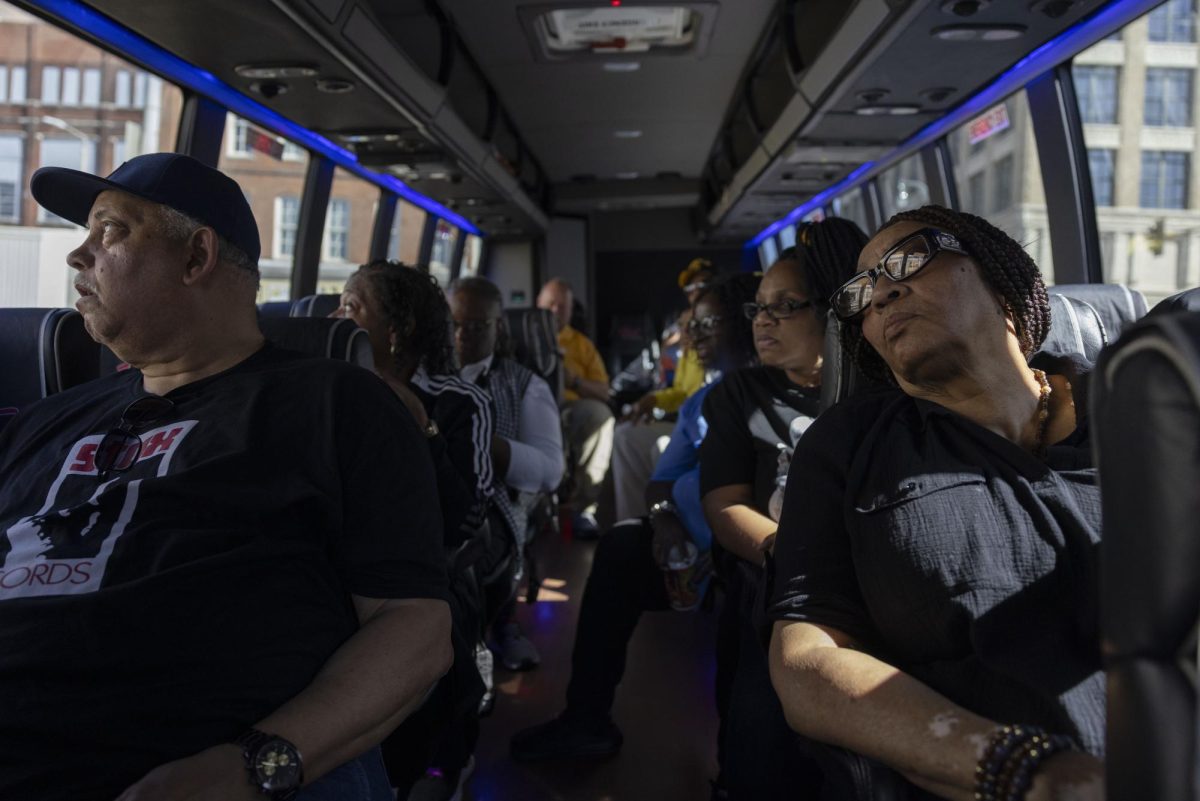14 years later, remembering Anne
September 21, 2015
Editor’s note: Anne Coleman was killed when a vehicle struck the bicycle she was riding on campus 14 years ago Monday. The following story was published on Sept. 20, 2002, about a year after her death.
In Anne Coleman’s untimely death, she taught this campus a lesson: the interaction between bicycles, cars and pedestrians was a dangerous concoction no longer to be ignored.
Coleman, an SIUC student who had been in the Dental Hygiene program for only five weeks, was killed in a crosswalk when a vehicle struck the bicycle she was riding one year ago Saturday.
Advertisement
It was a tragedy this university vowed would never be repeated as administrators and students alike rallied to find a solution to the dangerous, congested Lincoln and Douglas drives that cut through the heart of campus.
SIUC police got tough on speed violators, the campus speed limit was dropped five miles per hour, bushes and shrubs that blocked motorist’s views on roadways were removed, speeding fines were increased and a full-blown campaign emerged to bring more attention to crosswalk safety.
But has it worked? Has the passing of a year made busy campus roads safer?
SIUC student Lori Thornton was seriously injured in a crosswalk only two months after Coleman’s death. Injuries she sustained included a broken left clavicle, fractured right hip, a blood clot in her brain and cartilage damage to her left knee. She is still recovering.
There have been at least six other injuries in crosswalks since Coleman’s death, according to SIUC statistics. In 2001, there were nine less-severe accidents in crosswalks resulting only in property damage.
Glenn Poshard, vice chancellor for administration, said the university has addressed campus safety by taking a complete look at the traffic and parking policies. Freshman and sophomores who commute to campus are now required to park in the Arena, a move Poshard says takes 500 to 800 cars off the main road daily. SIUC police were told to make no exceptions when it comes to issuing tickets for drivers who fail to yield and bicyclists that do not to walk their bikes through crosswalks. A portion of Lincoln Drive will be rerouted in the next several years.
“Lincoln and Douglas drives are dangerous areas,” Poshard said. “We feel like we’ve done quite a bit to try to address this, but the bottom line is it’s within everyone’s power to prevent or avoid these accidents in the crosswalks.”
Advertisement*
And while Coleman’s death meant this university would no longer close its eyes to a dangerous traffic problem, it has been a grieving process for Coleman’s mother that one year has brought little comfort to.
Follow your heart wherever it takes you, and be happy. Life is brief and very fragile, and only loaned to us for awhile. Wake up every morning with the thought that something wonderful is about to happen.
A poster with those words inscribed on it still hangs in Annie’s bedroom among the rest of her things, still in place, and the unpacked boxes her mother couldn’t stand to sort through or throw away.
Annie was 26 years old when she died. Friends and family describe her as the girl with a contagious laugh who loved country music and dancing. She was always mindful to the little things in life such as compliments on a down day and sending cards between holidays just to say she cared.
“She was always wishing you days of blue skies,” Joanne said. “She sent them just to say she’s thinking about you.”
After her father died of skin cancer in 1996, Annie worked her way through community college and saved up enough money to venture to Carbondale in fall 2000. She was a sophomore at SIUC and had been accepted to the Dental Hygiene program just five weeks before her death. She was hired as a freshman to work as a student worker for the program and that was where she was headed on that fateful day in September that claimed her life.
“She was exceptional in every way. She loved coming to work. She loved what she was doing. She was excited about everything and was just a wonderful person to have around and to be working for you,” recalls Joan Jefferies, clinic manager for the Dental Hygiene Program. “When you found out it was her you go, ‘No, not Anne.'”
Following her death, friends who she had become close to in the program placed a hand-made cross near the sight of the accident and a sign that read “please slow down; our friend died here.”
To Cody Brewer, a junior in the program and one of the students who made the cross, Anne was the faithful friend she shared class and lunch with and convinced to sing on the stage during karaoke night at Mugsy’s the week before she died. When she thinks of Anne, she remembers her unrelenting kindness.
“One day sitting in class I had a red shirt on and she was like, ‘You look so good in red.’ I told her my mom bought this shirt,” Brewer said. “She was kind of like a mom figure to me.”
Anne had a job waiting for her when she finished school. Her former boss in the town neighboring Elgin, where she grew up, had promised her a position as soon as she finished her degree. Eventually, Anne wanted to go to work and start a family of her own.
“My friend’s children are starting to get married and starting to have children and that’s something Annie will miss out on,” her mother said.
It’s all the missing out and “what if” questions that make the days since her daughter’s death so difficult. Falling in love, having children and grandchildren, birthdays and holidays — all the things a mother hopes for a daughter, vanished in one tragic day.
“When parents send their children to school they expect their child to be safe,” she said.
It’s when she recalls the last conversation with her daughter that her voice finally breaks and she loses the fight to hold back her tears. It was a Wednesday, just two days before her daughter died: “We talked about her day, and it’s ironic because she was talking about moving out of Neely and moving into an apartment with a girl that was her age. They called themselves late bloomers because they were both 26. She said that she was tired of riding her bike to work,” Joanne said. “And so she was hoping to get into an apartment where she could drive to campus.”
And while there are painful memories every time she passes a crosswalk on the way to work and wonders why that car couldn’t stop, there are also pleasant ones.
“When I hear country music, I think of Annie. Beautiful fall days, I think of Annie. In the excitement of things, I think of Annie.”
In time, Joanne recognizes that the pain will ease and the burden of carrying her daughter’s memory will lessen. It brings her comfort to know she holds a place in Heaven and that her life was lived with few regrets.
That was the theme of the words her Uncle Bob delivered at her funeral: “She lived a full life, not so much in her years as in her many activities, her interests, her studies, her work and her social life. She loved life.”
Friends are planning to remember their classmate at an annual picnic this Saturday at a professor’s house. They are each going to plant a flower on a pond bank in her honor.
Carrie Stizman, a junior in the program and another close friend, believes Anne now has angel wings more perfect than the ones that she was so excited about wearing as a costume when Halloween rolled around.
“We always ate lunch together, and I remember her telling us that for Halloween she had ordered an angel costume and she could not get over how beautiful the wings were,” Stizman recalls. “That was two weeks before she died.”
She never got the chance to wear her wings — or perhaps she did.
Enforcing rules of the road on campus
Shortly after Coleman’s death, Chancellor Walter Wendler ordered the decision to lower the campus speed limit from 25 mph to 20 mph. New signs were purchased in January with the new speed limit posted and a reminder to bicyclists to walk their bicycles through crosswalks.
Wendler said traffic safety has been a major priority for the university since Coleman’s death, and that importance was reinforced for him last week when he rounded a corner near the Communications Building and struck another student’s car. He was ticketed for failure to yield on a left turn.
The effectiveness of the campus speed limit is still uncertain and police are still in the process of studying its effect. A study issued by the U.S. Department of Justice, however, states that even modestly slower speeds can increase the chance of survival for pedestrians struck by a vehicle.
But a decreased speed limit means nothing without police enforcement to back it up. Following Coleman’s death, SIUC stepped up its efforts in busting campus speeders.
Police issued 414 more warnings and tickets to speeders in the first four months of 2002, following Coleman’s death, compared to the first four months of 2001. They issued 210 more university speeding tickets, and the fines for those tickets have increased from $15 to $50 this year. Police also have the option of issuing state tickets and they gave out 79 more state tickets in 2002 than 2001 in the same four-month period. The amount of warnings issued increased by 125.
“The numbers indicate that we have certainly increased our efforts and concentrated resources in problem areas,” SIUC Police Lt. Todd Sigler said. “It could be that we are monitoring more closely. It could be increasing the time spent by the officers enforcing speeding laws. It could be that rather than giving written or verbal warnings the option has been to take the citation approach.”
Police also began enforcing the requirement that bicyclists walk their bikes through crosswalks, although on a smaller scale. Police issued no such tickets or warnings in the first four months of 2001 and issued 11 university tickets during that same period in 2002.
Sigler said SIUC police have directed more time to patrols and enforcement of road violators to address the problem. The flipside, however, to increased traffic enforcement is that other areas go unattended.
“Yeah, there is understaffing problems; I’m not going to sugarcoat it,” Sigler said. “You can only be in one place at one time. So yes, we have done what we can to increase efforts in the area of traffic safety, but crime deterrence or prevention is going to have a void.”
Understaffing is one pressure point that has the Fraternal Order of Police Labor Council, the union representing the SIUC police, and the university locked in contract negotiations. There is money in the budget for 44 officers, but the university has only employed 37 officers, according to an FOP report.
Although most facets of the university are clamoring for recourses, Wendler said increasing the staff of the police department is one of his top priorities.
To further pinpoint problem traffic areas, the university placed black data collecting boxes around campus in March. Information obtained from those boxes indicated that students travel nearly 9 mph more than the posted speed limit in the area approaching the Engineering Building, which is an area that also sees a high amount of foot and bicycle traffic. It determined that 7,726 vehicles drive through campus on a daily basis.
Poshard said administrators are planning to address congestion by rerouting Lincoln Drive to the west of the Communications Building, wrapping it around Campus Lake in the next three to five years as part of a broader land-use plan.
A speed display board was placed along Lincoln Drive near the Engineering Building, a mechanism Lt. Sigler said reminds drivers to slow down and pay attention.
Wendler and Poshard are still working to decrease traffic flow on Lincoln and Douglas drives. Requiring commuting freshman and sophomores to park in the Arena lot has taken upward of 800 cars off the road daily, Poshard said, and they would like to see even less traffic on the road. They encourage students to park once and walk to their classes throughout the day. The university has set aside $800,000 this year to provide a shuttle bus service from the Arena to areas around campus free of charge.
Bringing attention to the problem
The face of Anne Coleman is one this university will not soon forget. It is plastered along classroom entrances and buildings and SIUC public transportation. It’s a picture of a girl with golden locks and piercing eyes. The caption underneath reads: Future dental hygienist. Future wife and mother. No more future.
Police estimated the vehicle that struck Anne was traveling above the posted 25 mph speed limit and couldn’t see Coleman because of a van obstructing the driver’s view.
Anne’s picture is a subtle reminder of what can happen when people fail to obey the rules of the road, when people fail to pay attention and fail to slow down.
It was created as part of a larger crosswalk safety campaign by the Advocates for Crosswalk and Traffic Safety. The group formed following Coleman’s death and a series of less severe crosswalk collisions. They came together to bring awareness to traffic problems recent months had proved fatal.
The ACTS committee is looking for more involvement and they are having a meeting Monday to encourage more participation.
Annie’s mother also worked closely with the ACTS campaign and she wants students to start paying attention and the university to continue to study and address the problem. She doesn’t want to see any other parents have to suffer through the grief that she has dealt with in the last year.
In the time being, Joanne Coleman wants everyone to take a lesson from her daughter: Life is short and can end when you least expect it.
“Enjoy each day to the fullest because that’s what she did,” Joanne said. “Enjoy life. Enjoy each other.”
Advertisement










